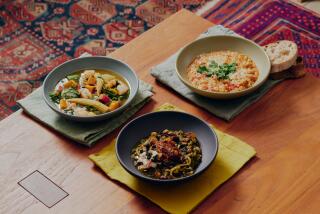Deliciously Simple by Harriet Roth (NAL Books: $17.95, 403 pp., illustrated)
The author attempts to educate the reader about a healthful way of eating by limiting sodium, fat, cholesterol and sugar, as recommended by health experts. Many of the recipes are easy and quick to make.
Harriet Roth, the author, promises her readers that half the recipes in the book will take only 30 minutes to prepare, “start to finish.”
That’s nice. But what about the other half? Well, glancing at the book, one will find things like bread pudding, carrot cake, oatmeal bread and multigrain bread, cassoulet, chicken casserole, a vegetable pastitsio, among dozens of others which require long cooking and processing. And that’s fine.
The point here is not only recipes that are “quick and easy,” but low-sodium, low-fat, low-cholesterol and low-sugar, too.
And all the recipes, brief or not, are that.
We like the book because the author attempts to educate the reader about a healthful way of eating by limiting sodium, fat, cholesterol and sugar, as recommended by health experts for all adults. The front of the book gives guidelines for reducing fats and cholesterol (removing skin-visible fat, and, if blood cholesterol level is at 185 milligrams or less, preparing very lean red meat such as flank steak and first-cut brisket). To limit sodium and salt, except for a touch added for taste, simply don’t cook with them.
There are also good tips on equipment, of which the microwave oven is No. 1 on the “must have” list, according to author.
Some of the arguments for the microwave oven, according to Roth are: They are energy-efficient, they don’t require preheating, they help preserve texture, color and, of course, nutrients in foods cooked in them. There is also a list of food you can freeze, refrigerate and dry store.
A menu section is a valuable one in any cookbook, because most people have problems creating menus. In this book, you’ll find several suppers or lunches, late breakfast, a dinner from leftovers, holiday menus, company dinners and even one for unexpected guests.
The recipe section begins with basic recipes, such as sauces, broths, mixes (baking mix among them), bouillon cubes, steamed rice and a special sour cream topping that is made with 1% fat cottage cheese and, therefore, low in calories.
Then the book gets into the heart of things--everything from soup to nuts, all low in fat, cholesterol, salt and sugar.
How is it done?
Well, to limit calories, sodium, cholesterol, fat and sugar in a tuna appetizer, Roth uses low-sodium baking powder and cold-pressed safflower oil and nonfat milk to make the point. The result is an appetizer containing 46 calories and a negligible amount of fat--about 0.9 grams. And that’s not bad.
How does Roth do with the pastas? Pretty well. There is a macaroni and turkey dish that contains 277 calories per serving with 3.9 grams fat, 26 milligrams cholesterol and 58 milligrams sodium. This meal in a dish would require nothing more than a glass of milk and a piece of fruit to round out the menu, making it well under a 500-calorie meal. There is a seafood tetrazzini with sodium hitting 141 milligrams per serving, but that, too, is relatively lower than its normal counterparts because the recipe is made with salt-free chicken broth and salt-free Swiss cheese.
There are quite a few fruit desserts because fruits are naturally low in calories, fat, cholesterol and sodium, but they are treated interestingly. There are blueberries and bananas made with a glaze of unsweetened apple juice concentrate and banana liqueur at 109 calories per serving. A cheese pie made with gelatin, low-fat cottage cheese and unsweetened apple juice concentrate also is relatively low in calories per serving--about 114. A papaya custard made with nonfat milk contains 105 calories, and a yogurt-banana-strawberry pie has 153 calories.
Among the breads there is a cornbread with only 57 calories per serving and banana muffins for 140 calories.
There are also a few miscellaneous, but valuable, recipes, including a mock creme anglaise made with nonfat powdered milk with only 15 calories per serving, a Spicy Barbecue Sauce containing nine calories per tablespoon serving, and a mustard sauce with 12 calories per two tablespoons.
SPICY BARBECUE SAUCE
1 (8-ounce) can salt-reduced tomato sauce
1 tablespoon dehydrated onion flakes or 1 small onion, minced
1 tablespoon dehydrated celery flakes or 1 stalk celery, minced
1/4 teaspoon garlic powder or 1 large clove garlic, minced
1/2 green pepper, seeded and minced
1 tablespoon Worcestershire sauce
1 teaspoon salt-free vegetable seasoning
1 teaspoon dry mustard
2 tablespoons lemon juice
2 tablespoons cider vinegar
2 tablespoons frozen unsweetened apple or pineapple juice concentrate
1 teaspoon liquid smoke, optional
Combine tomato sauce, onion flakes, celery flakes, garlic powder, green pepper, Worcestershire, vegetable seasoning, dry mustard, lemon juice, cider vinegar, apple juice and liquid smoke. Bring to boil. Cover, reduce heat and simmer about 10 to 15 minutes. Stir occasionally. Taste and adjust seasonings. Makes 1 1/2 cups.
Note: Sauce may be refrigerated or frozen for future use.
Per serving: 9 calories; 0.2 gm protein; 0 gm fat; 2 gm carbohydrate; 0.1 gm fiber; 0 mg cholesterol; 10 mg sodium.
SPECIAL SOUR CREAM TOPPING
1 pint 1%-fat cottage cheese
2 tablespoons nonfat yogurt
Place cottage cheese in blender or food processor and process until smooth. If desired, add yogurt for more piquant flavor.
Note: This mixture will keep in refrigerator several days or may be frozen, then defrosted, and blended well before using.
More to Read
Eat your way across L.A.
Get our weekly Tasting Notes newsletter for reviews, news and more.
You may occasionally receive promotional content from the Los Angeles Times.










